Book Review: Measuring Mother Earth
14 Jan


Paddlers drawn down the great rivers of the Canadian tundra – the Kazan, the Dubawnt, the Thelon – often find themselves crossing the path of one Joseph Burr Tyrrell.
Tyrrell, a geologist with the Geological Survey of Canada, was the first Euro-Canadian to descend the Dubawnt (in 1893) and the Kazan (as far as Yathkyed Lake, in 1894). The discoveries and conclusions he made during his two far northern canoe trips went a long way toward filling in the geographical and geological maps of Canada’s Barrenlands.
Heather Robertson’s new biography of Tyrrell, Measuring Mother Earth: How Joe the Kid Became Tyrrell of the North (McClelland and Stewart, $34.99), the first life of the explorer since Alex Inglis’ 1978 A Northern Vagabond, seeks to bring the well-traveled adventurer to life. Richly illustrated with archival photos, Robertson succeeds with mixed results.
Her rather short book – 318 pages not including notes and source information – skips over much of Tyrrell’s early and later life, rushes his epic northern trips (for the paddler/reader anyway), and meanders too frequently in the telling of Tyrrell’s story. Robertson’s occasional, novelistically imagined scenes from Tyrrell’s life and oddly informal narrative voice proves more distracting than illuminating.
Readers hoping Roberston’s treatment of Tyrrell would match Ken McGoogan’s works on northern explorers John Rae and Samuel Hearne will ultimately be disappointed. Still, Robertson’s book offers glimpses into the character of a self-centered man determined to make a name for himself. He at turns comes across as miserly (both with money and due credit), easy to anger, and regularly at odds with his wife Dollie.
Tyrrell, though, saw the Barrenlands as his path to fame and reward. While doing fieldwork on Lake Athabasca in 1892, he learned from natives of a route onto the un-mapped tundra. In completing his two epic northern trips he endured arduous travel and risked his life and those of his companions (which included his brother James on the Dubawnt trip) to fill in blank spots on the map.
The first tundra trip, a paddle from northern Saskatchewan’s Black Lake, descending the Dubawnt to the Thelon, and then out to Hudson’s Bay for Churchill, began on July 3 and would not reach Churchill until October 19, nor return completely from the wilds until December 31.
Robertson’s Tyrrell is a man propelled by his ambitions but limited by his imagination. Having stumbled upon an unknown population of inland-dwelling Inuit on the Dubawnt and Kazan Rivers, for example, he showed neither anthropological interest in studying them nor the facility with languages to bring their story to the outside. Study of the Caribou Inuit would have to wait three decades for the arrival of Knud Rasmussen.
Still, just as far northern paddles will continue to follow and cross Tyrrell’s routes, readers can do much the same with the explorer’s life on the pages of Measuring Mother Earth – catching images of an earlier traveler.
Also … If you’re interested in Tyrrell’s Barrenland trips, click HERE for the University of Toronto’s fine Tyrrell page.










